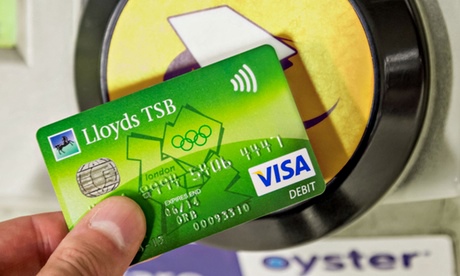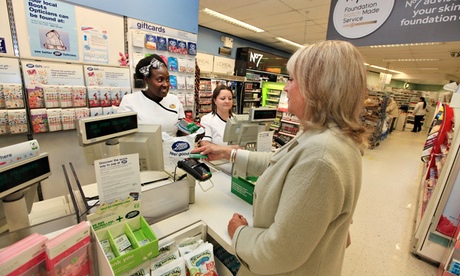Consumers are at risk of falling victim to fraudulent payments made on contactless credit and debit cards that have already been cancelled following a loss or theft.
Guardian research has revealed that banks do not automatically check many contactless payments, allowing thieves to continue to use stolen cards even after they have been cancelled. This is because some payments – such as when contactless cards are used to pass through London’s tube network barriers – are waved through as offline transactions and only checked later. One bank told the Guardian that virtually all transactions for less than £15 were not immediately checked.
Contactless technology allows customers to make quick payments by simply touching their card on to a terminal. There are now 74.5m contactless cards in circulation in the UK, and they have become more popular since the spending limit was raised from £15 to £30.
However, most customers will not realise that the cards cannot be completely cancelled if lost or stolen, and that some banks will expect the customer to spot and report fraudulent payments to reclaim their cash. Cards do contain a chip which limits losses, but they may be used until this limit is reached if the payment terminal is operating offline.
While a shop’s payment terminal might go online to process a payment and verify the card before allowing a sale, some transactions are made offline and only processed with the bank later. While this allows payments to be processed quickly, it also means that lost or stolen cards may be used even after being cancelled.
“The contactless facility on bank cards across the industry is designed to approve transactions ‘offline’ without referring to the account provider for authorisation, for the speed and convenience of customers,” says Gillian Fleming, spokesperson for First Direct and HSBC. A spokesman for RBS and NatWest, meanwhile, says: “In theory a small number of contactless transactions could be made before the card is blocked.”
RBS, Lloyds and Santander all say their systems can pick up contactless spending after a card is reported stolen, with Santander saying it would proactively contact customers to verify any payments, and Lloyds saying it would automatically refund any payment after a theft.
Barclaycard says: “When a customer reports a card lost or stolen, a block is applied to the card preventing all further activity. However, some contactless transactions are processed offline so may not appear on a customer’s account until after the block has been applied.” It says payments that had been made offline on the day of cancellation may be applied to accounts and would be refunded when the customer identified them; payments made on days after the cancellation will not be taken from an account.
At other banks the onus seems to be on customers to spot all rogue payments.
To date, fraud on contactless cards is low. Figures produced by the UK Cards Association show that in the first six months of 2015 there was £516,500 of fraudulent transactions on contactless cards – the equivalent of just 2p for every £100 spent using the technology.
However, the figure could understate the true level of losses as many customers are unaware that they can still be defrauded after reporting a card as stolen or lost. Geoffrey Barraclough, a payments and technology expert, thinks this could be the case: “The fraud statistics that are shared would only be fraud that the banks are aware of,” he says. “If nobody reports it – because, for instance, they didn’t know to look for it – the banks wouldn’t be aware of it. Unless you go through your statements there is no way of telling whether the cards are being used after you have cancelled them.”
A spokesman for the UK Cards Association says: “There is absolutely no evidence to suggest fraud on contactless cards is under-reported. Incidents of fraud are identified in a number of ways, not just by a customer, and all banks have advanced security systems in place to detect fraudulent transactions.
“As always, it is important to check bank or card statements regularly for any unusual transactions, especially if a card has been lost or stolen. Anyone who is a victim of card fraud will get their money back and will not be left out of pocket.”
As a security measure, contactless cards demand that a user keys in his or her pin number after a certain number of payments or when a certain financial threshold is met. This is set by the card provider and varies from bank to bank. There is no time limit on the payments, so until it is reached the card can continue to be used.
“Our cards do have a spend limit that triggers the card to ask for a chip and pin verification, which would then prevent someone from making contactless purchases on the card,” says a spokeswoman for TSB.
Banks are reluctant to reveal how many fraudulent transactions could take place before the pin number is requested. Tom Foxton, a spokesman for Barclaycard, says: “We wouldn’t give out that information as it would be useful for those intending to use the cards for criminal purposes.”
An unnecessary stress
Earlier this year I had my handbag stolen, writes Emma Hartley. I cancelled my cards, called the police to get a crime number and tried not to dwell on the uninsured personal items I’d lost. It’s only stuff, right?
But it wasn’t as easy as I’d hoped to put the incident behind me. A couple of days later I looked online and saw that my current account had been used by someone other than me.
I rang my bank, First Direct, and asked what was going on; how had my cancelled debit card been used three times in a McDonalds in Greenwich the previous day and twice on a garage forecourt? It’s because it’s a contactless payment card, I was told. I would need to keep an eye on my account and claim back any money that was lost through these fraudulent transactions.
At this point I was struck by the horrible thought that the First Direct debit card was not the only contactless payment card that had arrived, unasked for, through the post. A call to Barclaycard confirmed that the same thing was also happening with the two cards, a Visa and an Amex, attached to the same credit card account. Several of the fraudulent transactions were through Transport for London (TfL).
The person who stole my handbag also committed fraud totalling £135 across my various contactless payment cards, nearly all of which I was eventually able to reclaim (although there was a stray payment to TfL that I didn’t spot until later). What it meant, however, was that instead of being a one-off event, the theft continued for around a week: the last transaction was five days after my handbag was stolen.
Contactless payment made having my bag stolen far more stressful than it would otherwise have been.












